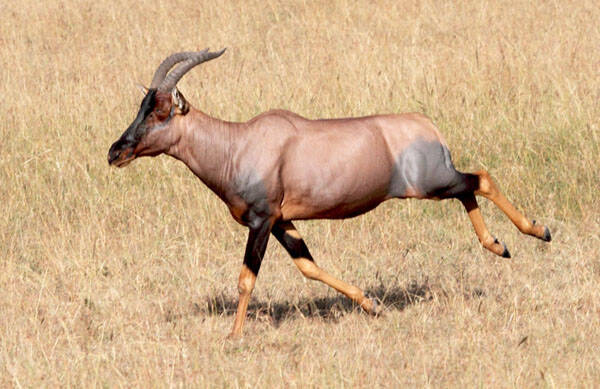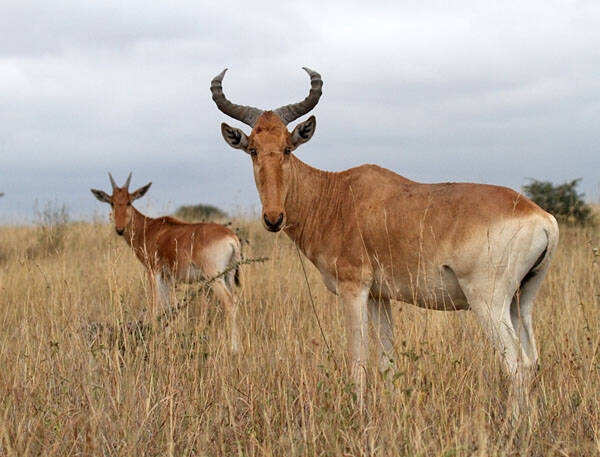Alcelaphus buselaphus
IUCN
LCBasic Information
Scientific classification
- name:Alcelaphus buselaphus
- Scientific Name:Alcelaphus buselaphus,Red Hartebeest
- Outline:Ungulata
- Family:Artiodactyla Bovidae Antelope
Vital signs
- length:1.5-2.45m
- Weight:120-200kg
- lifetime:11-20years
Feature
The face is narrow and long, the eyes are far from the horns, and the shoulders are higher than the hips.
Distribution and Habitat
Native: Angola, Benin, Botswana, Burkina Faso, Cameroon, Central African Republic, Chad, Democratic Republic of Congo, Côte d'Ivoire, Ethiopia, Ghana, Guinea, Guinea-Bissau, Kenya, Mali, Namibia, Niger, Nigeria, Senegal, South Africa, South Sudan, Sudan, United Republic of Tanzania, Togo, Uganda, Zambia and Zimbabwe.
Extinct: Algeria, Burundi, Egypt, Gambia, Israel, Jordan, Lesotho, Libya, Morocco, Somalia and Tunisia.
Possibly extinct: Eritrea.
Introduced: Eswatini.
Hartebeests are more tolerant of woodlands and tall grasses than other antelopes. They therefore prefer the edges of open plains; for example, they are often found on the edges of woodlands in open areas of the new grasslands of the Serengeti in Tanzania. They therefore appear to be an edge or transition zone species, generally avoiding more closed woodlands. On Mount Kenya, they can reach altitudes of up to 4,000 m. Hartebeest are almost entirely herbivorous, feeding selectively on grasslands at moderate
Appearance
The hartebeest is an ungulate with a body length of 1.5-2.45 meters, a tail length of 300-700 mm, a shoulder height of 1.1-1.5 meters, and a weight of 120-200 kg. Males are larger. The face is narrow and long, which is emphasized by the eyes being far away from the horns. Another characteristic of this species is that the shoulders are higher than the hips, forming a sloping slope on the back. The legs are long, with large glands under the eyes, and the tail is slender with tufts of hair at the end. The body hair is about 25 mm long and has a fine texture. The hartebeest has light-colored hair on most of the hips and chest and part of the face. The white hair on the hips may attract a mate or ward off an aggressor. There are 8 subspecies, and the color of the fur varies greatly between subspecies, from light tan to bright reddish brown to dark chestnut. Both sexes have strong horns, which are 450-700 mm in length. The shape of the horns also varies from subspecies to subspecies. The ho
Details
Red Hartebeest (scientific name: Alcelaphus buselaphus) is also known as Red Hartebeest in foreign languages. The Red Hartebeest and the Zambian Hartebeest were once independent species. In 2013, they were classified as subspecies of the Hartebeest. So far, the Hartebeest genus has only one species, the Hartebeest, with 8 subspecies. The North African Hartebeest (nominate subspecies) has become extinct.

Hartebeests forage for food in the early morning and late evening, and rest in the shade during the hot midday. They are highly adaptable to water and can drink water every day or go without water for several days. They are usually resident. They often stand on high ground to watch over the group and look out for approaching enemies. If they seem difficult to deal with, they will flee at a speed of up to 70-80 kilometers per hour. Hartebeests are very alert and cautious compared to other ungulates. They rely mainly on their vision to spot predators, and they snort to warn each other of impending danger. They move in single file, following behind members of the herd, with a somewhat awkward gait. Sometimes they huddle together, turning 90 degrees after only 1-2 strides in a given direction. Hartebeests do not migrate, but in extreme conditions, such as drought, populations may change areas of existence.
Male Hartebeests are aggressive and will fight if challenged. Any contact is preceded by a series of head rubs and butts, and dung is deposited. If that is not enough to repel the enemy, the male will hunch forward and jump up with a bent waist. Injuries and deaths do occur, but they are very rare. Females and young Hartebeests can move in and out of territories freely. Males lose their territories after 7-8 years.
Hartebeests are social animals that live in organized herds of up to 300 animals. They have been known to form aggregations of up to 10,000 animals. In a herd, there are four types of animals: territorial adult males; non-breeding adult males; a group of young males; and a group of females and sub-adults. Old males may live alone, while young and strong males form their own groups. Strong adult males lead females and their young and defend their territories. Females in a group consist of 5-12 animals, with up to four generations of offspring in each group. They do not form safety groups with other adult females. It is believed that there are strong dominance relationships between females, and these groups define the social organization for the entire herd. Females have been observed to fight and quarrel with each other on occasion. Male offspring may stay with their mother for up to three years, but will usually leave her for about 20 months to group with other young males. At 3-4 years of age, males may begin trying to claim a territory, which the females will take. Once a territory is established, males will defend it and usually will not leave.

Hartebeest are herbivores that feed almost exclusively on grass, according to the African Wildlife Foundation. During the rainy season (October to May), more than 95 percent of their food is grass, and grass never makes up less than 80 percent of their diet. Hartebeest in West Africa, in Burkina Faso, eat mostly bluestem during the rainy season. Between seasons, the main diet is grass stems. Hartebeests eat only small amounts of bracts and legumes throughout the year. At the beginning of the rainy season, jasmine is also part of their diet. They have a high tolerance for poor quality food. The long snout of the hartebeest allows for increased chewing power, allowing them to graze better than other antelopes. Therefore, when the availability of juicy grasses is limited, such as in the dry season, the hartebeest can also eat tougher, older grasses. It has been demonstrated elsewhere that hartebeests can digest a higher proportion of their food than other antelopes.
Hartebeest breeding occurs in territories protected by a single male, most often in open areas on plateaus or ridges. The male sniffs the female's genitals. If the female is in estrus, the male will follow, with his ears down. The male sometimes sticks to the side of the female and tries to stop her from moving forward. Once the female stands still, the male is allowed to mate. Mating is brief but may be repeated several times. Mating is interrupted if another male intrudes. Intruders are usually driven away. Reproductive expectations vary with season and region, depending on the species or subspecies of hartebeest in question. Hartebeest calves are usually born in October-November in South Africa, December to February in Ethiopia, and February-March in Nairobi National Park. The gestation period is 214-242 days. Females leave the group to give birth in the bush. This is a marked difference from the breeding habits of their close relatives, the wildebeest, which breed in large groups on the open plains. After giving birth, females leave their calves in the bush for several weeks, returning only to nurse. The calves are weaned at 4 months. Sexual maturity may occur as early as 12 months, but members of the species do not reach their maximum weight until 4 years of age. Hartebeests have a lifespan of 11-20 years.
Due to overhunting of wild animals for meat and the expansion of settlements and livestock farming, the number of hartebeests has decreased significantly throughout their range and their distribution has become increasingly fragmented. As has already occurred throughout much of the rest of the species' previous range, some key populations are declining due to poaching or other factors, such as drought and disease in some cases. For example, in the Nomo region, the number of hartebeests fell by 60% from 18,300 in 1984 to 5,200 in 1998 (Fischer and Linsenmair 2001). The distribution of most hartebeest subspecies is likely to become increasingly fragmented until they are restricted to areas where poaching and encroachment by livestock and settlements can be effectively controlled.
Listed in the IUCN Red List of Threatened Species in 2015, ver 3.1 - Least Concern (LC).
Protect wild animals and stop eating game.
Maintaining ecological balance is everyone's responsibility!








